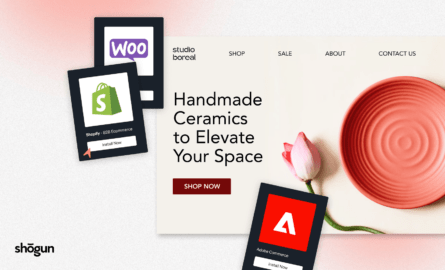Ecommerce Brands: Beware Becoming a Tech Company

There is no shortage of cool ways brands are innovating with their ecommerce experiences.
For example, Doe Lashes’ website, where shoppers can complete a “selfie” quiz:

The experience uses a QR code, 3D scanning, and even machine learning to measure a shopper’s unique eye shape and other factors to personalize a product suggestion. The experience is set up like a filter on a shopper’s phone with access to the camera:


Similarly, sunscreen brand Vacation Inc. has a ‘Vibe Generator’ on their site, allowing shoppers to curate their own music soundscape as they shop. They’re cleverly introducing in-store sensory merchandising online.

This level of detail speaks to the caliber of experience the brand wants you to have, no matter where you find them.
But as much as brands are innovating, some brands get caught up in the technology to support exceptional experiences. And this can mean losing sight of the company’s core focus.
There’s nothing wrong with wanting these types of experiences—or the tech that fuels them. It’s mainly an issue when a smaller scaling brand adopts full ownership over building or assembling complex custom tech stacks. The ongoing and total cost of ownership threatens to harm the growth of brands trying to scale.
Today we see brands raise the bar for shopping, especially as they adopt emerging headless technology—but they are also needlessly becoming tech companies in the process. This often comes with huge internal development teams devoted to creating and maintaining the tech stack that makes it possible.
And it’s risky.
My take is that becoming a tech company isn’t going to be what differentiates your online-first ecommerce brand in the eyes of your customers. In fact, I’d argue the cost of ownership can be harmful to your scaling business. It’s tough to leverage your tech in the best way if you’re drowning in its management and ongoing costs.
Today, I’m sharing why brands fall prey to this, plus what I think should be considered instead.
What happens when scaling brands double down on composing complex ecommerce tech
Makeup retailer Glossier comes to mind here. After raising a whopping $80 million Series E in 2021—reaching a $1.8 billion valuation—Glossier laid off a third of their staff in early 2022. The team most impacted was the technology team.
The brand cited they had made some mistakes, as CEO Emily Weiss shared:
“We prioritized certain strategic projects that distracted us from the laser-focus we needed to have on our core business: scaling our beauty brand.”
Weiss went on to say in a company-wide email:
“[W]e are shifting our technology strategy to leverage external partners for parts of our platform that we’re currently maintaining internally.”
Glossier wasn’t wrong for investing in tech to craft leading-edge shopping experiences. These types of experiences are needed to win amid customers’ high expectations. But taking on large teams to create the infrastructure in-house was a tall order among other critical ecommerce operations.
To understand why it’s still attempted, let’s quickly look at why brands are sometimes drawn to this approach:
1. Tech companies receive higher valuations than retail companies
It can be tempting to take on growth in this way because tech companies receive higher valuations. For example, Nordstrom’s price-to-sales ratio is 0.18 compared to Amazon’s 2.71 price-to-sales ratio.
Brands—under pressure from investors—may be attempting to bring technology projects in-house as a way to score higher valuations.
However, retailers have been valued historically based on a way to measure profitability: EBITDA, or earnings before interest, taxes, depreciation, and amortization. Because of this, retailers need to pay close attention to their sales and profit margin; you don’t get brownie points for simply building your own tech.
As I’ve covered before, now more than ever, brands need to double down on EBITDA or gain capital efficiency. You need to make your core business successful instead of undertaking your own complex technology internally (where this can be outsourced).
2. Brands are trying to meet customers’ higher-than-ever expectations
Call it whatever you want—a change in shopper behavior, or a post-COVID commerce shift—but more DTC brands are integrating new technology into their online shopping experiences because it caters to sky-high shopper expectations.
Competing for customer attention and dollars with other brands means jumping on tech-heavy trends like digital currency and gaming. We see this play out with brands like Hermès who dropped MetaBirkin NFTs, and with initiatives like Maybelline’s Zynga partnership.


Another way brands are adapting to evolving shopping habits is via headless commerce. But the way many approach going headless—with a highly custom, Jamstack build requiring the individual sourcing of each site component—is too complex and heavy on company resources. Entirely composable headless sites involve complete top-to-bottom management of the infrastructure and a ton of DevOps.
This is where brands get into hot water: They either don’t have the adequate internal resources for a totally custom build and have to hire a team to manage and maintain all the modular pieces, or they have to revert back to their previous site and start from scratch again.
The problem is the complexity that traditional paths to headless introduce for brands during a period when they’re trying to scale (which is hard enough operationally!). Taking on a Jamstack approach to the tech yourself—when that isn’t your brand’s core ability—is not how you can deliver value for your shoppers.
The challenge of building a complex stack
Where we see the issue of brands building a complex, composable stack become problematic is when their needs don’t align with a super-custom solution, and management becomes overwhelming.
There are brands that can take on infrastructure and be fine, and brands that should outsource tools and SaaS instead.
For example, if you’re as big as Nike, it can make sense to build your ecommerce tech solutions (for going headless or otherwise) in-house and in a composable fashion. You may need something ultra-custom because you’re at such a scale. This to fuel something like this hybrid digital/in-person shopping experience:
Credit: Demodern Creative Technologies
It’s capital-intensive to build something in-house and have a full-time team dedicated to managing that tech. It boils down to capital efficiency.
And so, a smaller scaling brand—as with Glossier—will have a challenging time with huge internal projects and infrastructure to support them. Instead, building these experiences with outsourced tools or SaaS is more cost-effective, reduces overhead, cost-of-ownership, and is easier for the team to manage.
You can still gain the experiences you want; you just no longer need to take on the DIY nature of things or assemble everything from scratch.
Not sure where you fall on this spectrum? Here are a few questions to consider:
- Will shoppers’ experience be noticeably different when you take on the work of building a composable stack vs. implementing a SaaS solution?
- Does your company have the internal resources (i.e., several react developers) and budget to support an entirely custom in-house solution?
- If selecting components for a composable headless build, how (and who) will maintain your tech internally? (is this cost of ownership worth the potential gains of the tech you’re selecting or have a strong opinion on?)
Brands sometimes learn the hard way how difficult it is to take on managing an entire ecommerce experience themselves—while also trying to focus on building a community, brand, marketing operations, logistics, and quality product.
How can you approach your tech stack instead?
I think its great merchants are leaning into emerging tech to delight customers and grow. But these days, there are countless new solutions aimed at simplifying your job as an ecommerce operator.
The “old” ways of doing things are (fortunately) no longer the only ways.
For example, if you’re a mid-size brand with tons of mobile traffic, conversions, and sales, and it’s clear your site performance is lacking, you may consider a progressive web app (PWA) solution via headless commerce.
But you’ll want to approach your path to headless carefully.
Some avenues to headless are more complicated than others. Entirely composable builds require your brand to source, manage, and maintain every individual component of the site.
You can consider whether traditional paths to headless are worthwhile or if you can try out an emerging solution for the same outcome.
I’m biased, but the radically different approach to headless builds we’re taking over at Shogun is something we’re excited about. We’ve unified all the components of a frontend build with a SaaS approach, and it’s allowed dozens of brands to go headless without the overhead or huge risks.

You can ultimately look at ways to reduce cost, complexity, and vendor management—so you can go to market faster and impact revenue more quickly.
#cta-visual-fe#<cta-title>A radically different approach to headless commerce.<cta-title>Learn more about how all-in-one frontend platform Shogun Frontend simplifies going headless vs. taking your build in-house. Learn more
It’s all about finding software solutions that are the right fit for your team and needs. If it doesn’t empower your ecommerce team, make their lives easier, and align with your budget, move on to the next solution.
Ecommerce tech is not the differentiator. Your experience is
Ultimately, remember your approach to ecommerce tech should cater to what your brand needs and can handle as you grow.
It’s critical to remember that no matter the hype around certain terms in the ecommerce technology space, it’s all about differentiating via your shopping experience.
In other words: your customers won’t know what CMS you’re using—or care whether you built and assembled all your middleware yourself! They’ll only experience your storefront’s frontend and whether it was smooth, memorable, and worthy of a purchase.
How you get there? That’s up to you.
#cta-visual-fe#<cta-title>A radically different approach to headless commerce.<cta-title>Learn more about how all-in-one frontend platform Shogun Frontend simplifies going headless vs. taking your build in-house. Learn more

Nick Raushenbush
Nick Raushenbush is the cofounder of Shogun, software for building the next generation of ecommerce websites. Shogun helps 18,000+ ecommerce brands drive conversions, including Leesa mattresses, Gaiam yoga apparel, K-Swiss, MVMT watches and Chubbies shorts. Before Nick started Shogun, he founded a creative agency that has done work for Google, Roku, Soylent and Pokemon Go.



